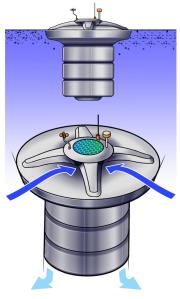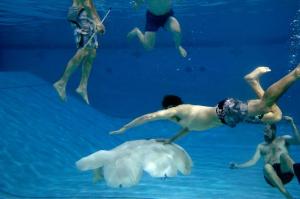This post will be updated occasionally with links that could be useful in developing concepts for a robotics project to work with Algilita.
relevant Blogs and Scoop it:
Ralph Schneider Design Web site. Scoop it : Marine Litter
Vamfun Scoop it: Synthetic Sea Solutions
Marcela Garcia: Marine-Litter
Commercially Available:
Spray glider: This is drone submarine that is equipped with a CTD (for conductivity, temperature and depth)
that measures temperature, salinity and pressure, as well as an optical sensor
that measures the turbidity, which is related to the biomass in the water. I might be capable of being adapted to sampling plastic… not sure yet.

Wave glider : This sensor platform uses the energy of the waves for propulsion. Solar panels and battery power the electronics. Has great long term sustainability and can be independently controlled using gps navigation system and satellite links. Currently used for meteorological data collection and ocean surveillance…but I think it could be easily modified to contain plastic sampling sensors to monitor ocean surface plastic density.
Current Measuring App for IPhone/IPad
The Clean Oceans Project is planning to use this to direct their plastic scimming boat to the heavy debris areas of the bay. Hopefully this techonolgy can be extended offshore.
“We put together what we thought recreational boaters would find helpful so they could see what the currents are going to be,” said Toby Garfield, professor of geosciences and director of the university’s Romberg Tiburon Center for Environmental Studies. “The GPS actually shows up in the app. So when you are in the Bay, you can see what the currents are doing.”

http://www.oeatech.com/2012/04/iphone-ipad-app-for-codar-current-data/
Concepts:
http://thecleanoceansproject.org/plastictofuel.php
http://www.youtube.com/embed/8qBFlOqLnJ8?feature=player_detailpage
Nick Drobac, Founder and Executive Director of The Clean Oceans Project, is interviewed by LivingECO.com’s Ken Spector. Featured in the interview is the plastic to oil machine that could help to clean up the world’s oceans including the Northern Pacific Gyre.
Project _ Floating Horizon (Ralph Schneider)

Here is a link to Ralphs ppt.
Marine Drone Although this doesn’t seem practical for marine debris collection due to the conglomeration of different types of flotsam…It may have some use in the short-term collection of samples under a watchful eye. Popular Science article .

Here was a post that pointed out some problems with the drone and brought some new ideas about a floating plastic processing island that was self sustaining.
Marine Litter Extraction Project
Boyan Slat conceptual project that is stationary and proports to minimize by_catch of marine life due to the use of booms rather than nets. He recently gave a TEDxDelft talk. I have had some correspondence with him re the details of the project. He claims that the clean-up of the ocean can be greatly accelerated …i.e. from Capt Charles Moores 79000 years to less than 10 years:) His talk went viral and many news sources picked up his concept and presented it as a feasible method to clean up the gyre plastic. This sparked a interesting and informative rebuttle by the 5gyres Stiv here http://inhabitat.com/the-fallacy-of-cleaning-the-gyres-of-plastic-with-a-floating-ocean-cleanup-array/. It should be fun to watch where Boyan’s concept evolves to in the next 5 years.

Bio-Pod
Pod Project (abundantseas.org/pod_project)
The Pod’s shell is made of recycled plastic. Inside, the Pod features a geometry that draws plastic particles into the chamber and a proprietary mesh that entangles the particles for permanent sequestration. Moreover, such mesh also absorbs Hydrophobic chemicals.  The Pod also helps restore the marine biome. Its exterior shell provides anchor points for biomass to grow and flourish. This is assisted by the Pod’s porous scrap metal ballast, which releases iron ion nutrients to feed marine life. Note: biomass growth will increase the base of the food chain and, further, naturally sequester carbon-dioxide.
The Pod also helps restore the marine biome. Its exterior shell provides anchor points for biomass to grow and flourish. This is assisted by the Pod’s porous scrap metal ballast, which releases iron ion nutrients to feed marine life. Note: biomass growth will increase the base of the food chain and, further, naturally sequester carbon-dioxide.
Therefore, overtime, the each Pod becomes an island sanctuary for new marine life, and it permanently sequesters floating plastic, along with chemical contaminants: toxins that cannot be netted and, thus, are among the greatest threats to the food chain.
degrading Technologies
New Organism Found In Ocean Lives Off Plastic Now this seems to be the best of all worlds. An organism that feeds on plastic and hopefully has non toxic waste. Of all the methods I have come across this trumps them all. We need an army of these organism and hopefully they can become part of the ocean ecosystem.
Prototyped projects:
Midland High School Passive scooper …with a great write-up. This is the kind of write-up that I desire for Grant High School Project.
This project homepage #09-2004 was developed by Mainland High School in Daytona Beach, Florida, in response to the 2009-2010 Internet Science and Technology Fair

OpenROV: Open Source Remote Operated Marine Drone

Plans available for about $10.
Virginia Tech is working on Cryo jellyfish. It has eight legs and a 5 ft diameter silicon body cover with lots of sensors to monitor the ocean. Perhaps could be adapted to the plastic pollution problem in some way.
Plastic properties:
Mainland High School Summary: Nice intro to plastic properties
Plastic sorting:
Optical
Sonora Environmental Research Institute, Inc. (SERI) developed a low cost optical sorter
capable of distinguishing among plastics, glasses and ceramic as well as general opaque,
transparent or translucent materials.
http://www.seriaz.org/downloads/Color_Sorter_final_report.pdf
This sorter is doable by our robotics team. It uses LED’s and low-cost light sensor. The rest would be manipulating the plastic into the sorter with some type of conveyor and building a solenoid controlled air pressure nozle to expel plastic from the conveyor. Again all doable and possibly using some vex processors

Density Sorting
Great paper on using very dense Zinc Chloride solution to sort plastics provided to me by Miriam Goldstein of Scripts.
Title: “A novel, highly efficient method for the separation and
quantification of plastic particles in sediments of aquatic
environments ” by Hannes K. Imhof , Johannes Schmid2#, Reinhard Niessner2, Natalia P. Ivleva2, and Christian Laforsch1,

Research Papers Links:
Algalita postings:


[…] article on Marine Debris, and for other robotic solutions for cleaning up the plastic, see Resources relevant to sampling and removal of plastic from oceans. Read on to see Boyan Slat’s TEDxDelft talk: How the oceans can clean […]
Hi Chris, thanks for listing my project FloatingHorizon. 🙂
[…] article on Marine Debris, and for other robotic solutions for cleaning up the plastic, see Resources relevant to sampling and removal of plastic from oceans. Read on to see Boyan Slat’s TEDxDelft talk: How the oceans can clean […]